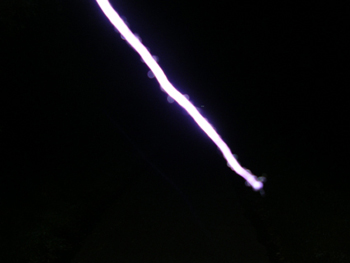 |
Purple color & multiple BOLs surround light tube at crop circle
field (original photo). Overall ambient light is pitch-black,
although flash did fire. |
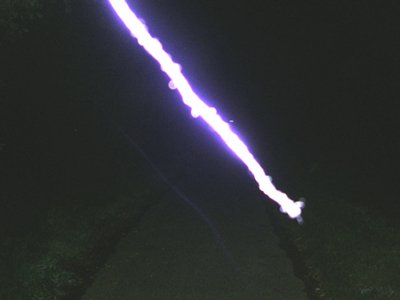 |
When contrast is enhanced many small BOLs can be seen clustered
around the tube. |
All photos in this report are taken by Robbert v/d Broeke unless
otherwise noted & may not be reproduced without written permission
from him, or the BLT Research Team.
|
Over the years Robbert v/d Broeke has taken a wide range of photos which have what I am calling "light tubes" in them. The BLT photo consultant has examined a number these photos taken by Robbert with my Pentax, some indoors and some outside in crop circle fields near Hoeven. The consultant has offered an hypothesis as to how some of these photographs might be approximated by deliberately manipulating an artifact in front of the camera lens as the flash is fired. The discussion which follows is based primarily on "light tube" photos taken by Robbert in in his living room during my August, 2007 visit to Holland.
Examination of Light Tube Photos
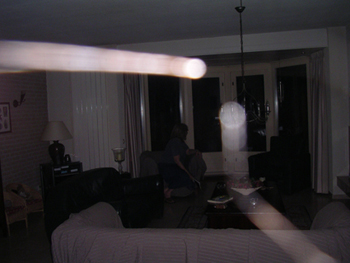 |
One of a series of "light tube" photos taken by Robbert indoors
in August '07, and examined by the BLT photo consultant. |
In some of the photos from this particular series the analyst has overlaid two sequential shots to illustrate the fact that, although the light tubes are higher in one frame than the next, the shape of the tubes has not changed.
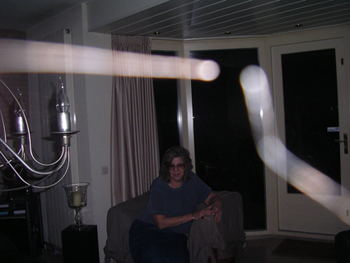 |
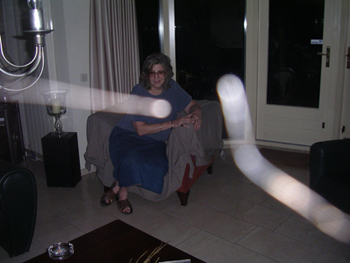 |
Two sequential photos, taken 6 seconds apart, which were
examined by photo analyst. |
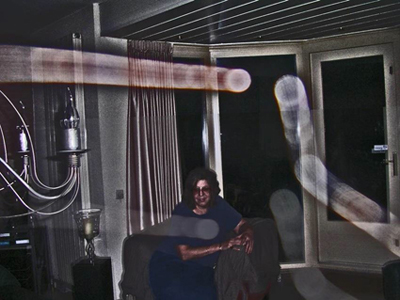 |
Same two photos superimposed with enhanced contrast & correctly
distorted so that perspective is the same.
(Superimposition by BLT Photo Analyst.) |
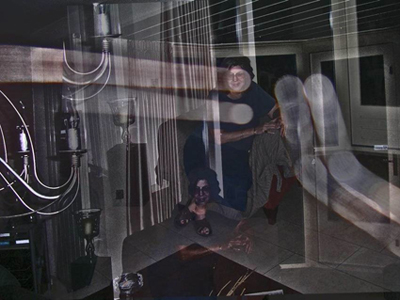 |
Here the two frames are overlaid so that light tubes are adjacent;
overall shape of the light tubes is the same.
(Superimposition by BLT Photo Analyst.) |
The fact that the shape of the light tubes does not change in multiple shots in this series supports the idea that a physical artifact of some kind has been manipulated in front of the camera lens--that the camera has actually recorded a "whole displaced object" positioned in front of the lens, reflecting the light of the flash. Also, the fact that the light tubes never appear to go behind any physical objects in the frame and, additionally, that the "balls of light" inside the tubes are the same size as the tubes themselves support this "artifact" theory.
Finally, in spite of the perception that the tubes are actually moving balls of light, we observe that they do not disappear in sequential frames shot within seconds of each other—when we might expect that they would have moved out-of-frame.
In essence our photographic analyst suggests that a thin strand (or strands) of something like plastic picture-hanging wire or fishing line (or even a strand of hair) which have had one or more imperfections "dinged" into their outer edge with a sharp knife—and then held partially in front of the camera lens and partially in front of the flash—could simulate both light tubes and the presence of the BOLs which seem to be inside them in many photos.
When a translucent fiber which is out of focus to begin with (because it is too close to the lens) is lit up by the camera flash, any imperfections (the "dinged areas," held in front of the lens) show up as spheres where the light hits the imperfections; a ball of light would also occur where the light exits the strand. The result could be a photo which seems to have captured a moving BOL (with multiple internal BOLs) going so fast that a "light tube" was created.
In this scenario, all one would have to do would be to prepare one or several such thin plastic strands or hairs or whatever in advance, then glue or somehow adhere them to one's fingers--and then inobstrusively introduce them in front of both the lens and the flash apertures as one takes the photos. |
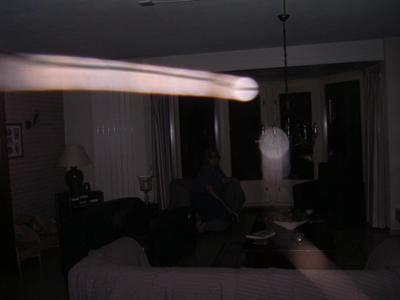 |
Light tube with dark streak. This and many other shots in this series are much
darker than the actual room light. |
However, there are problems with our analyst's hypothesis. We see clearly the wisdom of the argument presented so far and that some of the observed facts can be accounted for with a mechanical solution. But there are several equally clear observations which are not accounted for, which our analyst has also pointed out.
In this series we can also see that (a) the light-tubes change position from photo to photo shot in rapid sequence, (b) there is an evolving pattern of BOLs inside the light tubes themselves, not to mention the dark streak in the photo above which occurred in only this one shot, (c) the tubes do not throw shadows, and (d), most interestingly, the light tubes appear to be adding light (making certain objects in their trajectory more visible)—all of which factors argue against the "artifact in front of the lens" hypothesis.
We can also rule out one other possible causative factor—if Robbert's light tubes were caused by scratches or water spots or anything else on the lens itself one would anticipate that these "artifacts" would appear in roughly the same place in each frame (unless the zoom has changed)—a possibility which is at odds with the observed situation.
Another difficulty is the fact that several of the photos in this series are much darker than the actual room lighting—and these shots are interspersed with photos in which the lighting is accurately represented. Our analyst sugggests that the flash may have been partially covered by a finger from time to time, thus reducing the amount of light reaching the subject, but my personal observations of Robbert's handling of the camera do not support this idea. The analyst also points out that there may have been a "default" of some kind in the "auto" mode of the camera (a problem the camera's Operating Manual warns can occur if the camera is exposed to "strong electromagnetic radiation" and/or "magnetic" fields); the analyst also raises the possibility that "the [light tube] is only visible to the camera because the flash somehow created it, or made it visible."
From my direct personal observations of the actual circumstances present when Robbert's photos have been taken, these questions suggest approaches to the situation which I think would be quite productive.
Attempts to Replicate Light Tubes and BOLs
Below are a few of our photo analyst's light tube and BOL simulations, created with a 2-inch long .035-inch diameter piece of clear plastic picture-hanging "wire," the last half-inch of which has been "dinged" with a sharp knife in about 10 different places. One end was positioned over the flash, the "dinged" section over the lens.
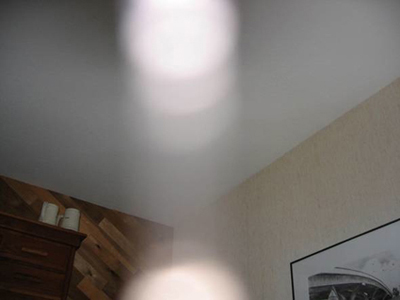 |
 |
Two simulations of "light tubes with BOLs," created by holding plastic "wire" with
imperfections close to the lens as the flash is activated.
(Photos by BLT Photo Analyst.) |
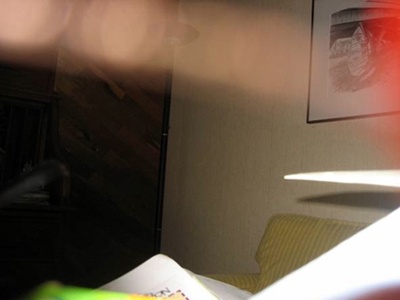 |
Another simulation which includes a pink & red "haze" which our analyst attributes
to illumination of the lens from the side & "light bounce" inside the camera.
(Photo by BLT Photo Analyst.) |
|
If we are to consider how well the "artifact in front of the lens" idea fits our actual light tube photographs we have to consider a few more relevant points. The most pertinent of these, of course, is that Robbert would have had to carry out multiple and varied manipulations constantly and surreptitiously, without Nancy (or, in numerous additional instances, other people who are watching intently for just such manipulation) noticing. He would also have had to introduce this particular type of "light tube" anomaly in amongst many other very different anomalies, in hundreds of photographs, indoors and out, over ten years and throughout several hundred multiple-hour photo sessions. Is this possible? Perhaps. Is it probable? I don't think so.
And then there is the problem that the hypothesis offered here does not explain multiple other "light tube" photos taken by Robbert. One instance would be those in which the widths of the tubes can vary in one single photo. When I first saw this photo, below, I thought it might be a hair in front of the lens; but then I realized that Robbert has very short hair and, further, this particular tube ends before the top of the frame….where, if it had been a hair, it would have had to begin. Because it was a totally dry night, I have discounted the possibility of this photo being caused by a moisture droplet.
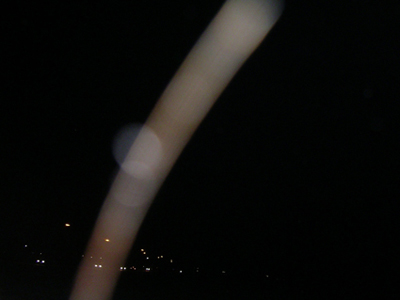 |
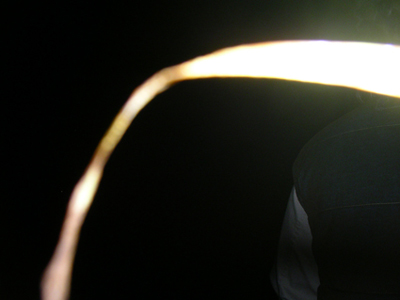 |
Two light tubes with varying widths, both taken on dry nights in crop circle fields. |
Another fact which is at variance with our "artifact" theory is that, in many of our light tube photos, one can clearly see BOLs which are outside the tubes altogether—apparently clustered around the light tubes as if "attracted" to them or perhaps an artifact of them. These BOLs cannot be explained as tiny imperfections cut into strands of plastic "wire"—and they are also not moisture droplets or dust or insects--so what are they?
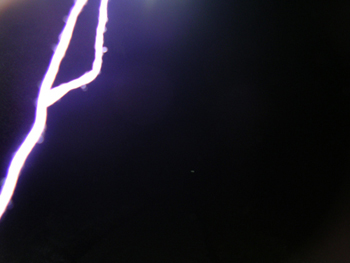 |
Bifurcated light tube with multiple tiny BOLs outside the primary anomaly.
Ambient light is again pitch-black, although flash did fire. |
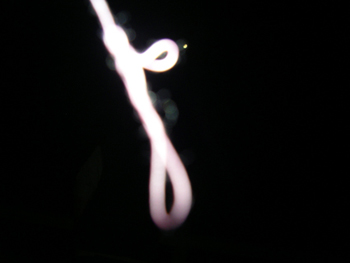 |
A more complex light tube with attendant BOLs. Camera is aimed at
Nancy & the unnatural darkness has occurred again.
(Yellow dot is the moon.) |
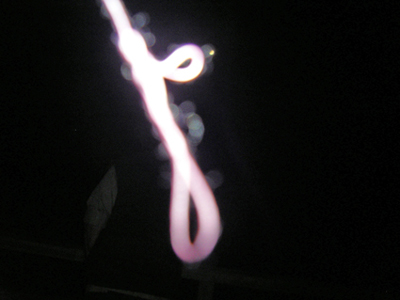 |
When "auto fix" is applied multiple small BOLs are clearly present—why are
they clustered only near the light tube? |
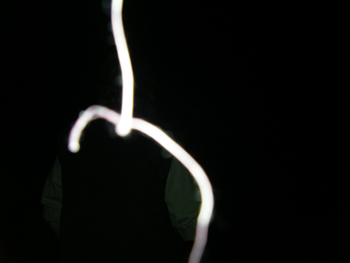 |
Same night—in one photo only the light tube splits & "frames"
Nancy's shoulders. |
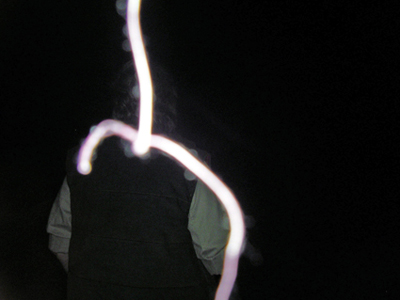 |
When "auto fix" is applied both Nancy's back & the small BOLs adjacent
to the light tubes are more visible. |
In many of Robbert's photos taken with my camera the anomalies appear to involve me. If we consider Robbert's consistent reports that he perceives an external "energy" present during these sessions and, further, that he is convinced that these energies are (a) responsible for the various anomalies but (b) that they do not emanate from him but come through him, we may make some sense of this.
Since I am usually in Holland for only 2-3 weeks each year it is logical that Robbert tends to focus on me while I'm present. We have also become good friends over the years and, so, it makes sense to me that he may somehow be directing these energies—consciously or unconsciously—at me, or in my direction. I guess it could also be possible that these energies themselves are attracted to, or directed at, me while I am with Robbert, although one would think that after all these years I'd be more aware of them if this were so.
When we are taking photographs inside Robbert's house we usually do so between 1am-4am, mostly because various family members are up and using the downstairs rooms until about midnight on most nights. During my Easter, 2008 visit we turned off all of the lights downstairs except for the under-counter lights in the kitchen.
During this particular night dozens of brilliant light tubes occurred—a whole series clearly aimed directly at a small ceramic Buddha's head statue which sits in a corner of the room where there is no light fixture of any kind. Over and over Robbert felt the "energy" presence in that section of the room and the photos indeed record that it was the statue which was the "target" of these brilliant light tubes. In the middle of this series of photos the ambient light in the room suddenly changes, appearing much darker in the photos than it really was, in spite of the flash continuing to fire—and then a series of "crosses" occurred directly in front of the Buddha's head.
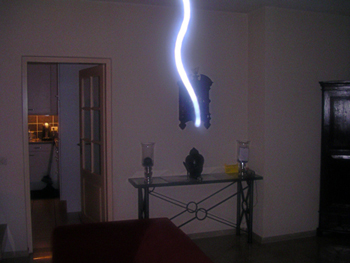 |
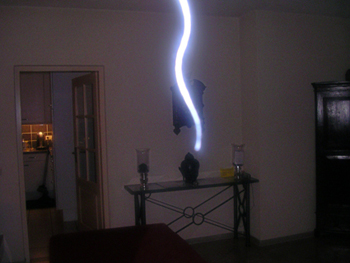 |
Two in the series of photos of light tubes aimed at Buddha's head statue.
There are no lights on in this room. |
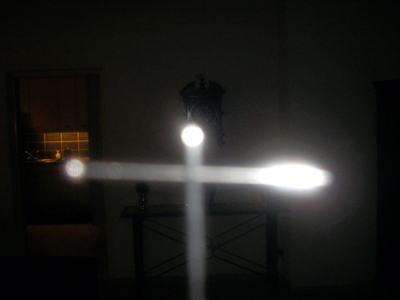 |
Ambient light now very dark, in spite of the fact that the flash continues to fire;
light "cross" is directly in front of statue. |
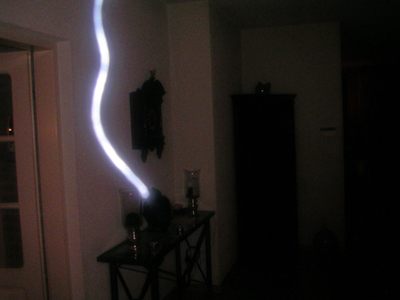 |
Robbert shoots toward statue from a different angle. From this angle light tube
appears to be made up of fast-moving light balls. |
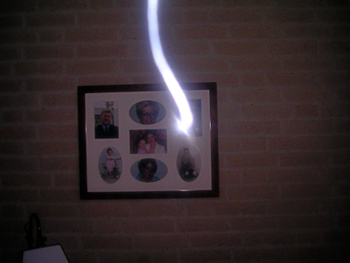 |
Here, the light tube is aimed directly at a photo of Robbert on the wall,
one of a framed group of family photos. |
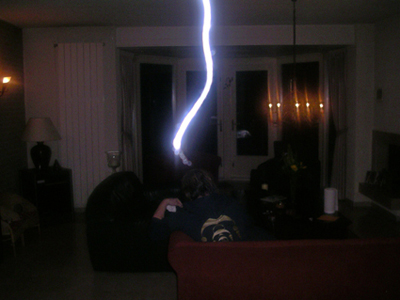 |
Later that night (chandelier & sconces now on) light tubes & BOLs occur again,
aimed directly at Nancy, sitting on sofa. |
Another type of "light tube," one that is green in color, has appeared many times now but always outdoors. Before these started to occur I had received a photograph taken by a French colleague which contained a pretty green anomaly, and I really loved the color. In fact, I had privately hoped that Robbert and I would someday get this color in one of our photo sessions.
The following summer (2007) green light tubes did begin to appear when I got to Holland. I had said absolutely nothing to Robbert about the French photo or my private desire to see this color appear. [My French colleague does not know Robbert, and his photo is not posted on the web.] Actually, Robbert's green tubes were not precisely the same hue of green—Robbert's are generally slightly more chartreuse--but I was nonetheless amazed. I felt as if "somebody" must have read my mind, a sensation many crop circle colleagues have reported when bizarre events have occurred around them for which they could find no other explanation.
These green light tubes have occurred mostly in fields where crop circles had previously been present and/or other very bizarre events have been recorded—but I think they are related more to Robbert's presence than to any other single factor.
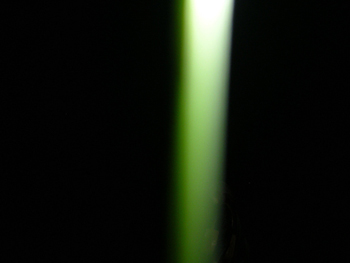 |
Green light-tubes appear the year after Nancy's private wish for such
a color.Although flash fired, Nancy (right behind tube) isn't visible. |
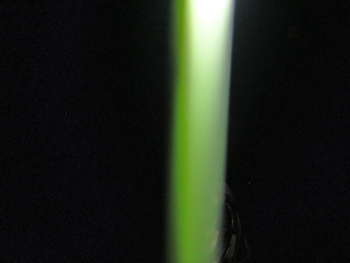 |
When "auto fix" is applied to photo, Nancy can be seen just a few feet
behind light tube. |
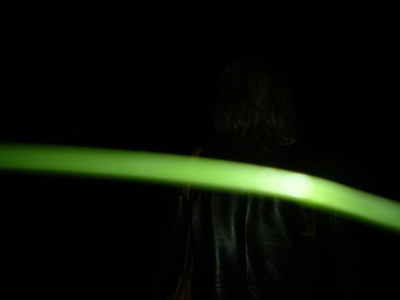 |
In same field, green tube with white BOL crosses Nancy's back. Again,
the flash on camera has fired. |
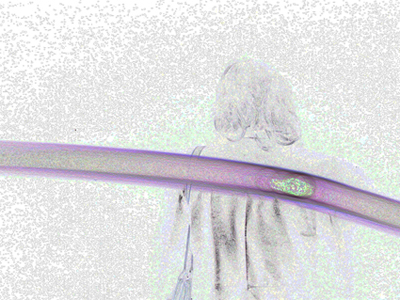 |
High contrast & "edge find" applied to same photo.
(Photo: BLT photo analyst) |
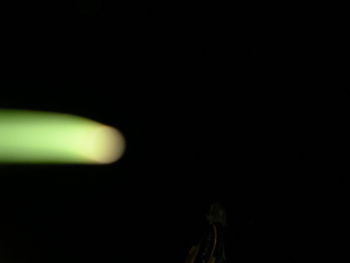 |
Light tube which appears to start, or end, in mid-air. Although flash
did fire, photo is again unnaturally dark. |
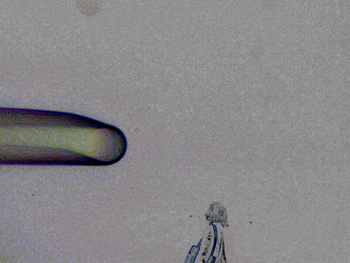 |
Same photo with high contrast & "edge find" applied.
(Photo: BLT photo analyst) |
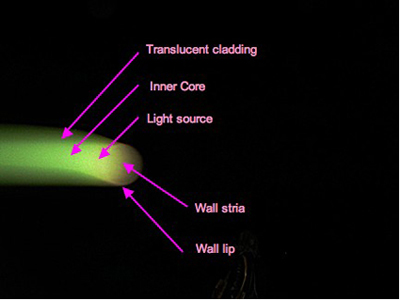 |
Photo consultant's labeling of various aspects of light tube.
(Photo: BLT photo analyst) |
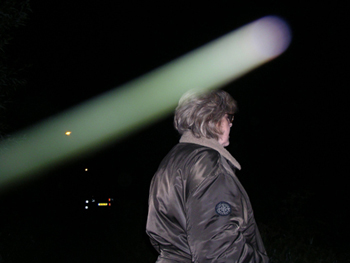 |
In 2008, the green light-tubes appear again; here the scene is lit
as it should be in a flash photo.
Why is this not the case in the others? |
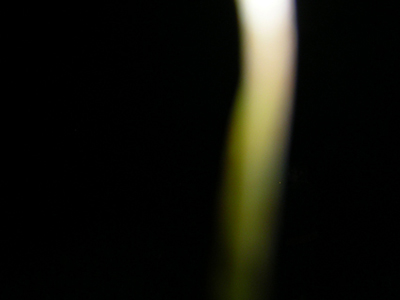 |
The position, width, shape, color & overall darkness of the green
"light tube" photos vary, although flash always fires
& photos are taken seconds apart. |
The reader is urged to remember that the photographs selected here are only a small fraction of the overall library. I personally have several hundred more taken by Robbert with my camera and there are thousands and thousands more taken by Robbert using his own camera or cameras which belong to many other people. My purpose in this report is to suggest both the variety of anomalies which regularly occur and their incredible volume—in this case mostly taken with my camera, to which Robbert's access is restricted to those times when I hand it to him.
It is only sensible that we should all—in particular those people who have not witnessed one of these photo sessions themselves--look, first, for prosaic explanations for these strange images. However, it seems to me that at some point Occam's razor (if nothing else) suggests it is unreasonable to refuse even to consider facts which point to possibilities which veer off into the unknown.
© 2009 BLT Research Team Inc.
All Rights Reserved
photos/illustrations can not be reproduced in any media
except with written permission from the
BLT Research Team
|
|